Evaluating Theories, Models, and Legal Codes for Effective Supervision
VerifiedAdded on 2023/06/15
|13
|4338
|444
Report
AI Summary
This report provides a comprehensive overview of professional supervision, focusing on the theories and models that underpin its practice, as well as the relevant legal and regulatory codes. It begins by evaluating various supervision models, including developmental, integrated, and orientation-specific models, highlighting their strengths and weaknesses in different contexts. The report then explains the legal and regulatory code of practice, emphasizing the importance of compliance with employment acts, health and safety laws, and anti-discrimination legislation. Furthermore, it discusses how evidence-based practice informs professional supervision, ensuring that interventions and strategies are effective and aligned with best practices. The overall aim is to provide insights into how effective professional supervision can improve performance, support staff well-being, and ultimately enhance the quality of health and social care services, while adhering to ethical and legal standards. Desklib offers similar resources for students.

PROVIDING
PROFESSIONAL
SUPERVISION
PROFESSIONAL
SUPERVISION
Paraphrase This Document
Need a fresh take? Get an instant paraphrase of this document with our AI Paraphraser
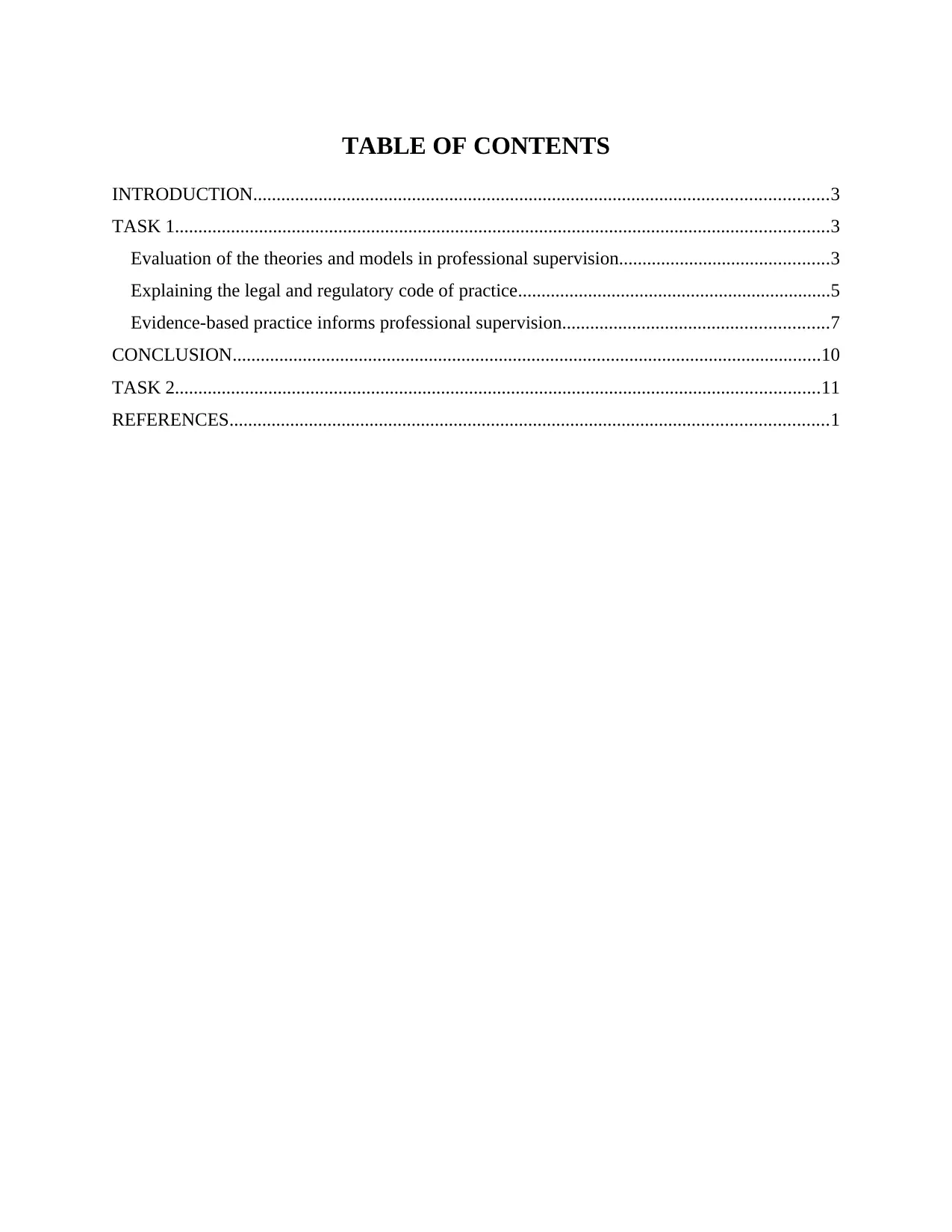
TABLE OF CONTENTS
INTRODUCTION...........................................................................................................................3
TASK 1............................................................................................................................................3
Evaluation of the theories and models in professional supervision.............................................3
Explaining the legal and regulatory code of practice...................................................................5
Evidence-based practice informs professional supervision.........................................................7
CONCLUSION..............................................................................................................................10
TASK 2..........................................................................................................................................11
REFERENCES................................................................................................................................1
INTRODUCTION...........................................................................................................................3
TASK 1............................................................................................................................................3
Evaluation of the theories and models in professional supervision.............................................3
Explaining the legal and regulatory code of practice...................................................................5
Evidence-based practice informs professional supervision.........................................................7
CONCLUSION..............................................................................................................................10
TASK 2..........................................................................................................................................11
REFERENCES................................................................................................................................1
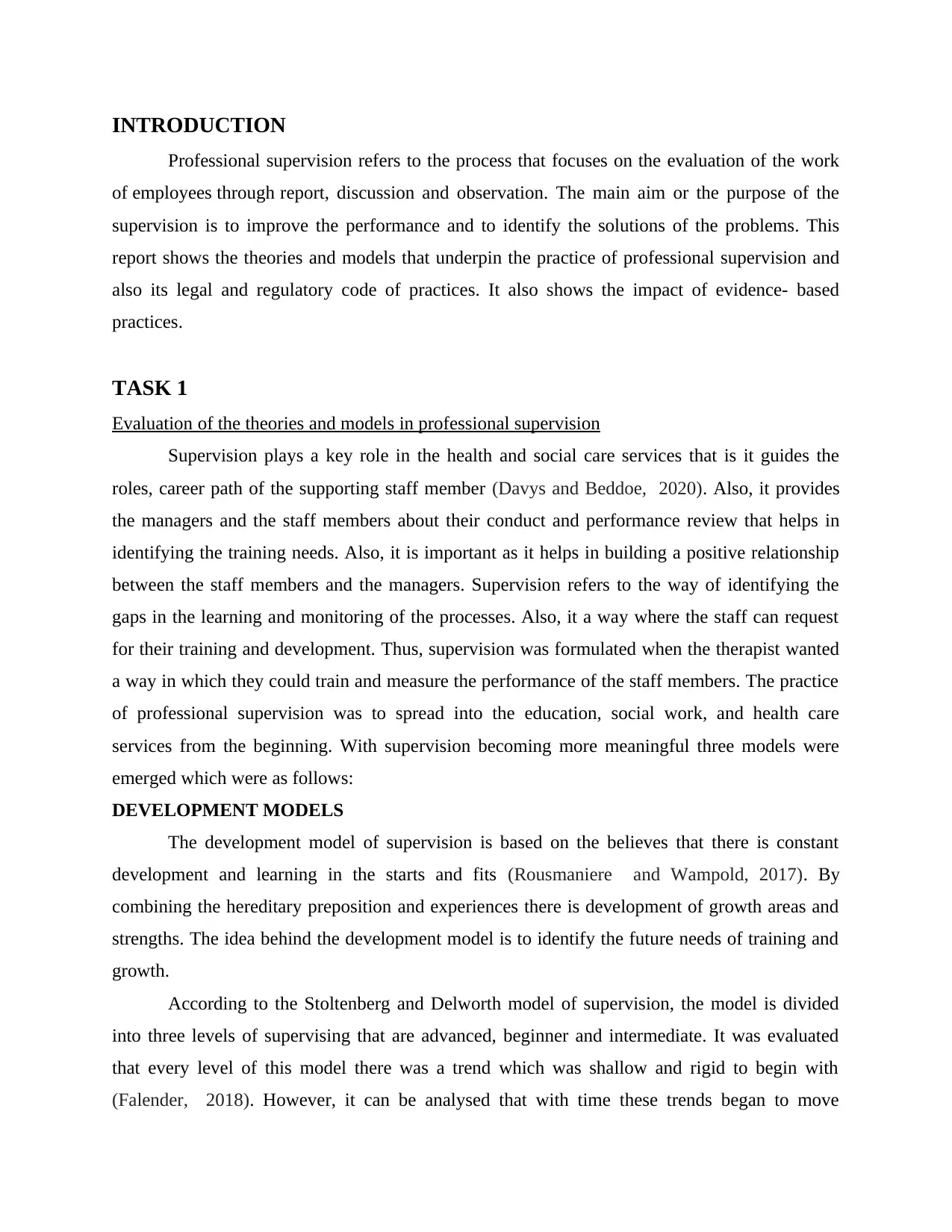
INTRODUCTION
Professional supervision refers to the process that focuses on the evaluation of the work
of employees through report, discussion and observation. The main aim or the purpose of the
supervision is to improve the performance and to identify the solutions of the problems. This
report shows the theories and models that underpin the practice of professional supervision and
also its legal and regulatory code of practices. It also shows the impact of evidence- based
practices.
TASK 1
Evaluation of the theories and models in professional supervision
Supervision plays a key role in the health and social care services that is it guides the
roles, career path of the supporting staff member (Davys and Beddoe, 2020). Also, it provides
the managers and the staff members about their conduct and performance review that helps in
identifying the training needs. Also, it is important as it helps in building a positive relationship
between the staff members and the managers. Supervision refers to the way of identifying the
gaps in the learning and monitoring of the processes. Also, it a way where the staff can request
for their training and development. Thus, supervision was formulated when the therapist wanted
a way in which they could train and measure the performance of the staff members. The practice
of professional supervision was to spread into the education, social work, and health care
services from the beginning. With supervision becoming more meaningful three models were
emerged which were as follows:
DEVELOPMENT MODELS
The development model of supervision is based on the believes that there is constant
development and learning in the starts and fits (Rousmaniere and Wampold, 2017). By
combining the hereditary preposition and experiences there is development of growth areas and
strengths. The idea behind the development model is to identify the future needs of training and
growth.
According to the Stoltenberg and Delworth model of supervision, the model is divided
into three levels of supervising that are advanced, beginner and intermediate. It was evaluated
that every level of this model there was a trend which was shallow and rigid to begin with
(Falender, 2018). However, it can be analysed that with time these trends began to move
Professional supervision refers to the process that focuses on the evaluation of the work
of employees through report, discussion and observation. The main aim or the purpose of the
supervision is to improve the performance and to identify the solutions of the problems. This
report shows the theories and models that underpin the practice of professional supervision and
also its legal and regulatory code of practices. It also shows the impact of evidence- based
practices.
TASK 1
Evaluation of the theories and models in professional supervision
Supervision plays a key role in the health and social care services that is it guides the
roles, career path of the supporting staff member (Davys and Beddoe, 2020). Also, it provides
the managers and the staff members about their conduct and performance review that helps in
identifying the training needs. Also, it is important as it helps in building a positive relationship
between the staff members and the managers. Supervision refers to the way of identifying the
gaps in the learning and monitoring of the processes. Also, it a way where the staff can request
for their training and development. Thus, supervision was formulated when the therapist wanted
a way in which they could train and measure the performance of the staff members. The practice
of professional supervision was to spread into the education, social work, and health care
services from the beginning. With supervision becoming more meaningful three models were
emerged which were as follows:
DEVELOPMENT MODELS
The development model of supervision is based on the believes that there is constant
development and learning in the starts and fits (Rousmaniere and Wampold, 2017). By
combining the hereditary preposition and experiences there is development of growth areas and
strengths. The idea behind the development model is to identify the future needs of training and
growth.
According to the Stoltenberg and Delworth model of supervision, the model is divided
into three levels of supervising that are advanced, beginner and intermediate. It was evaluated
that every level of this model there was a trend which was shallow and rigid to begin with
(Falender, 2018). However, it can be analysed that with time these trends began to move
You're viewing a preview
Unlock full access by subscribing today!
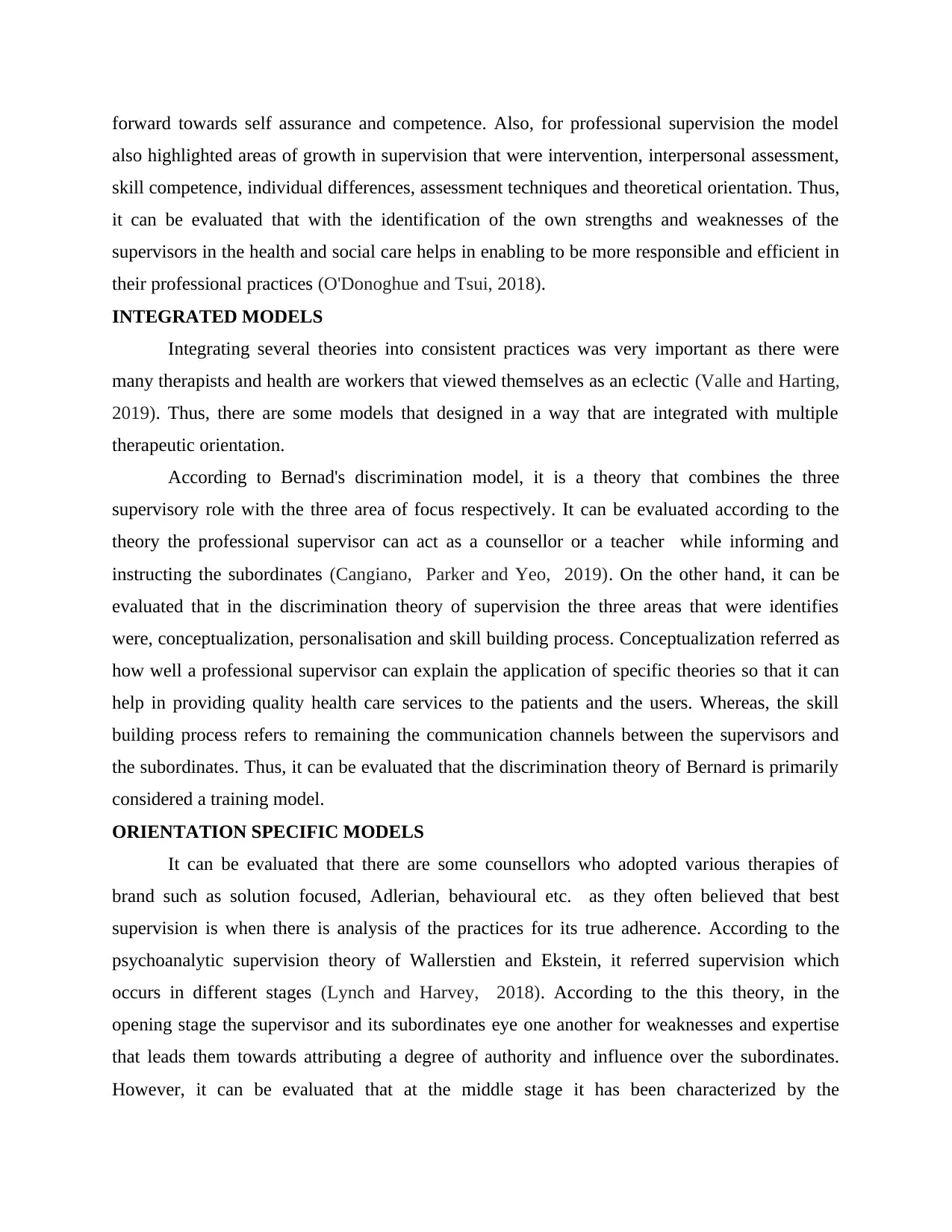
forward towards self assurance and competence. Also, for professional supervision the model
also highlighted areas of growth in supervision that were intervention, interpersonal assessment,
skill competence, individual differences, assessment techniques and theoretical orientation. Thus,
it can be evaluated that with the identification of the own strengths and weaknesses of the
supervisors in the health and social care helps in enabling to be more responsible and efficient in
their professional practices (O'Donoghue and Tsui, 2018).
INTEGRATED MODELS
Integrating several theories into consistent practices was very important as there were
many therapists and health are workers that viewed themselves as an eclectic (Valle and Harting,
2019). Thus, there are some models that designed in a way that are integrated with multiple
therapeutic orientation.
According to Bernad's discrimination model, it is a theory that combines the three
supervisory role with the three area of focus respectively. It can be evaluated according to the
theory the professional supervisor can act as a counsellor or a teacher while informing and
instructing the subordinates (Cangiano, Parker and Yeo, 2019). On the other hand, it can be
evaluated that in the discrimination theory of supervision the three areas that were identifies
were, conceptualization, personalisation and skill building process. Conceptualization referred as
how well a professional supervisor can explain the application of specific theories so that it can
help in providing quality health care services to the patients and the users. Whereas, the skill
building process refers to remaining the communication channels between the supervisors and
the subordinates. Thus, it can be evaluated that the discrimination theory of Bernard is primarily
considered a training model.
ORIENTATION SPECIFIC MODELS
It can be evaluated that there are some counsellors who adopted various therapies of
brand such as solution focused, Adlerian, behavioural etc. as they often believed that best
supervision is when there is analysis of the practices for its true adherence. According to the
psychoanalytic supervision theory of Wallerstien and Ekstein, it referred supervision which
occurs in different stages (Lynch and Harvey, 2018). According to the this theory, in the
opening stage the supervisor and its subordinates eye one another for weaknesses and expertise
that leads them towards attributing a degree of authority and influence over the subordinates.
However, it can be evaluated that at the middle stage it has been characterized by the
also highlighted areas of growth in supervision that were intervention, interpersonal assessment,
skill competence, individual differences, assessment techniques and theoretical orientation. Thus,
it can be evaluated that with the identification of the own strengths and weaknesses of the
supervisors in the health and social care helps in enabling to be more responsible and efficient in
their professional practices (O'Donoghue and Tsui, 2018).
INTEGRATED MODELS
Integrating several theories into consistent practices was very important as there were
many therapists and health are workers that viewed themselves as an eclectic (Valle and Harting,
2019). Thus, there are some models that designed in a way that are integrated with multiple
therapeutic orientation.
According to Bernad's discrimination model, it is a theory that combines the three
supervisory role with the three area of focus respectively. It can be evaluated according to the
theory the professional supervisor can act as a counsellor or a teacher while informing and
instructing the subordinates (Cangiano, Parker and Yeo, 2019). On the other hand, it can be
evaluated that in the discrimination theory of supervision the three areas that were identifies
were, conceptualization, personalisation and skill building process. Conceptualization referred as
how well a professional supervisor can explain the application of specific theories so that it can
help in providing quality health care services to the patients and the users. Whereas, the skill
building process refers to remaining the communication channels between the supervisors and
the subordinates. Thus, it can be evaluated that the discrimination theory of Bernard is primarily
considered a training model.
ORIENTATION SPECIFIC MODELS
It can be evaluated that there are some counsellors who adopted various therapies of
brand such as solution focused, Adlerian, behavioural etc. as they often believed that best
supervision is when there is analysis of the practices for its true adherence. According to the
psychoanalytic supervision theory of Wallerstien and Ekstein, it referred supervision which
occurs in different stages (Lynch and Harvey, 2018). According to the this theory, in the
opening stage the supervisor and its subordinates eye one another for weaknesses and expertise
that leads them towards attributing a degree of authority and influence over the subordinates.
However, it can be evaluated that at the middle stage it has been characterized by the
Paraphrase This Document
Need a fresh take? Get an instant paraphrase of this document with our AI Paraphraser
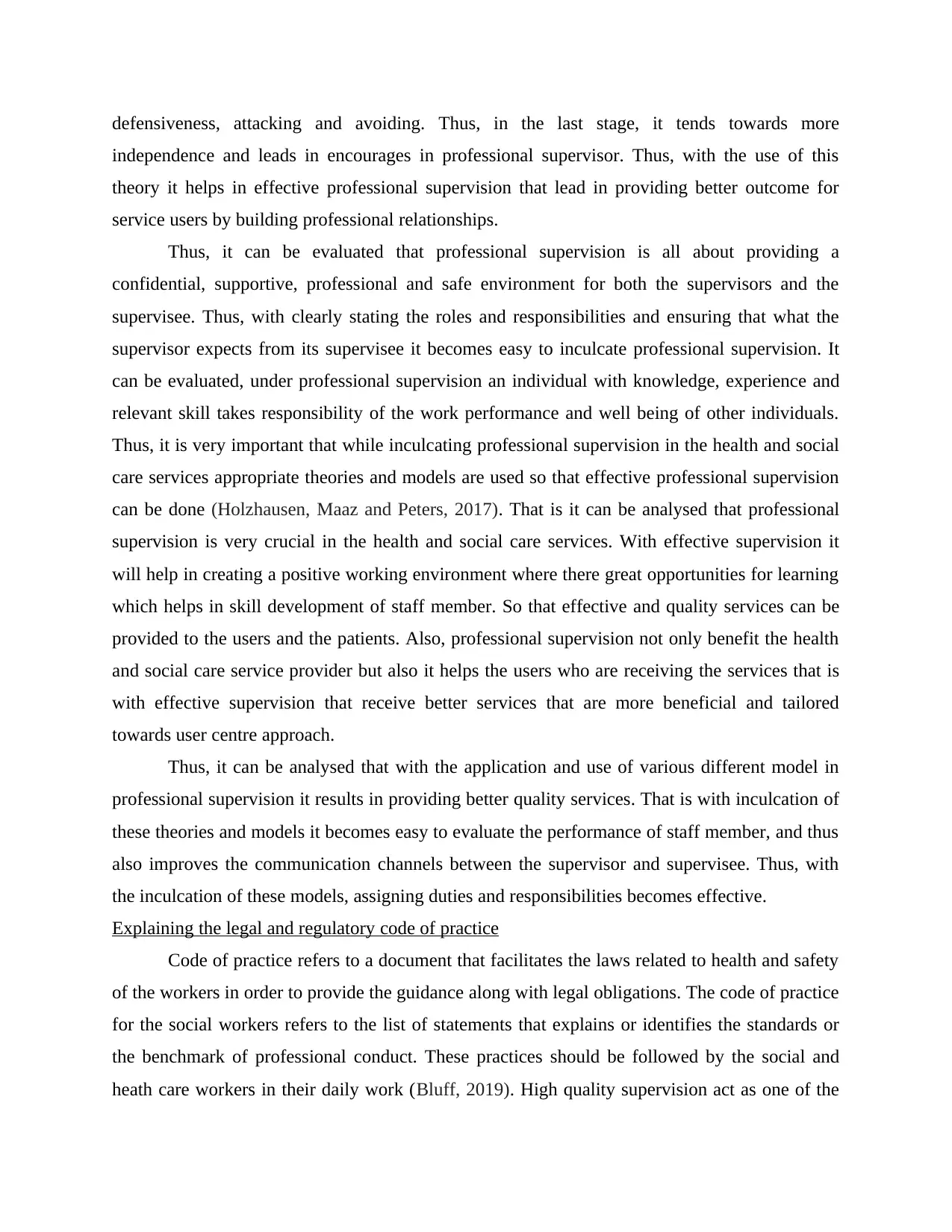
defensiveness, attacking and avoiding. Thus, in the last stage, it tends towards more
independence and leads in encourages in professional supervisor. Thus, with the use of this
theory it helps in effective professional supervision that lead in providing better outcome for
service users by building professional relationships.
Thus, it can be evaluated that professional supervision is all about providing a
confidential, supportive, professional and safe environment for both the supervisors and the
supervisee. Thus, with clearly stating the roles and responsibilities and ensuring that what the
supervisor expects from its supervisee it becomes easy to inculcate professional supervision. It
can be evaluated, under professional supervision an individual with knowledge, experience and
relevant skill takes responsibility of the work performance and well being of other individuals.
Thus, it is very important that while inculcating professional supervision in the health and social
care services appropriate theories and models are used so that effective professional supervision
can be done (Holzhausen, Maaz and Peters, 2017). That is it can be analysed that professional
supervision is very crucial in the health and social care services. With effective supervision it
will help in creating a positive working environment where there great opportunities for learning
which helps in skill development of staff member. So that effective and quality services can be
provided to the users and the patients. Also, professional supervision not only benefit the health
and social care service provider but also it helps the users who are receiving the services that is
with effective supervision that receive better services that are more beneficial and tailored
towards user centre approach.
Thus, it can be analysed that with the application and use of various different model in
professional supervision it results in providing better quality services. That is with inculcation of
these theories and models it becomes easy to evaluate the performance of staff member, and thus
also improves the communication channels between the supervisor and supervisee. Thus, with
the inculcation of these models, assigning duties and responsibilities becomes effective.
Explaining the legal and regulatory code of practice
Code of practice refers to a document that facilitates the laws related to health and safety
of the workers in order to provide the guidance along with legal obligations. The code of practice
for the social workers refers to the list of statements that explains or identifies the standards or
the benchmark of professional conduct. These practices should be followed by the social and
heath care workers in their daily work (Bluff, 2019). High quality supervision act as one of the
independence and leads in encourages in professional supervisor. Thus, with the use of this
theory it helps in effective professional supervision that lead in providing better outcome for
service users by building professional relationships.
Thus, it can be evaluated that professional supervision is all about providing a
confidential, supportive, professional and safe environment for both the supervisors and the
supervisee. Thus, with clearly stating the roles and responsibilities and ensuring that what the
supervisor expects from its supervisee it becomes easy to inculcate professional supervision. It
can be evaluated, under professional supervision an individual with knowledge, experience and
relevant skill takes responsibility of the work performance and well being of other individuals.
Thus, it is very important that while inculcating professional supervision in the health and social
care services appropriate theories and models are used so that effective professional supervision
can be done (Holzhausen, Maaz and Peters, 2017). That is it can be analysed that professional
supervision is very crucial in the health and social care services. With effective supervision it
will help in creating a positive working environment where there great opportunities for learning
which helps in skill development of staff member. So that effective and quality services can be
provided to the users and the patients. Also, professional supervision not only benefit the health
and social care service provider but also it helps the users who are receiving the services that is
with effective supervision that receive better services that are more beneficial and tailored
towards user centre approach.
Thus, it can be analysed that with the application and use of various different model in
professional supervision it results in providing better quality services. That is with inculcation of
these theories and models it becomes easy to evaluate the performance of staff member, and thus
also improves the communication channels between the supervisor and supervisee. Thus, with
the inculcation of these models, assigning duties and responsibilities becomes effective.
Explaining the legal and regulatory code of practice
Code of practice refers to a document that facilitates the laws related to health and safety
of the workers in order to provide the guidance along with legal obligations. The code of practice
for the social workers refers to the list of statements that explains or identifies the standards or
the benchmark of professional conduct. These practices should be followed by the social and
heath care workers in their daily work (Bluff, 2019). High quality supervision act as one of the
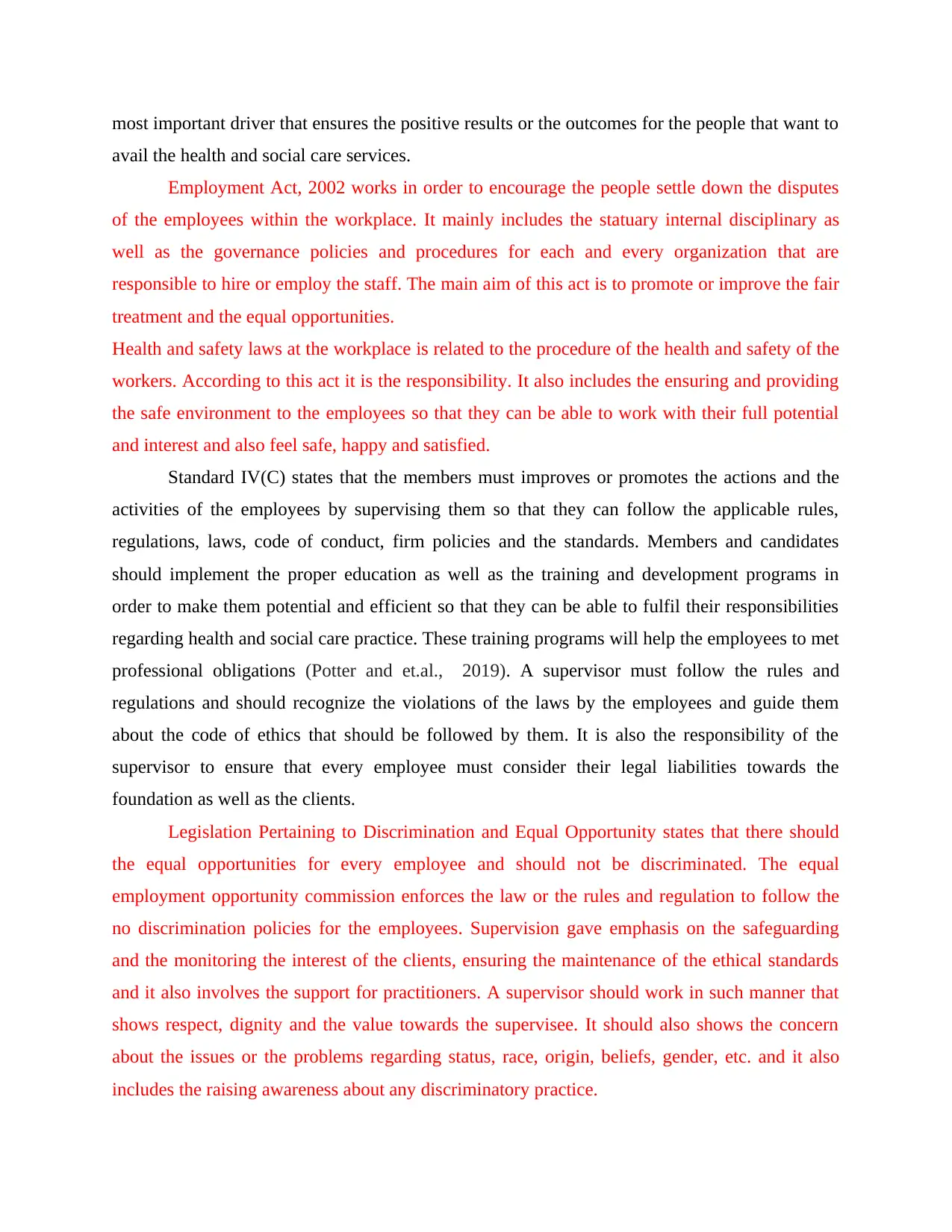
most important driver that ensures the positive results or the outcomes for the people that want to
avail the health and social care services.
Employment Act, 2002 works in order to encourage the people settle down the disputes
of the employees within the workplace. It mainly includes the statuary internal disciplinary as
well as the governance policies and procedures for each and every organization that are
responsible to hire or employ the staff. The main aim of this act is to promote or improve the fair
treatment and the equal opportunities.
Health and safety laws at the workplace is related to the procedure of the health and safety of the
workers. According to this act it is the responsibility. It also includes the ensuring and providing
the safe environment to the employees so that they can be able to work with their full potential
and interest and also feel safe, happy and satisfied.
Standard IV(C) states that the members must improves or promotes the actions and the
activities of the employees by supervising them so that they can follow the applicable rules,
regulations, laws, code of conduct, firm policies and the standards. Members and candidates
should implement the proper education as well as the training and development programs in
order to make them potential and efficient so that they can be able to fulfil their responsibilities
regarding health and social care practice. These training programs will help the employees to met
professional obligations (Potter and et.al., 2019). A supervisor must follow the rules and
regulations and should recognize the violations of the laws by the employees and guide them
about the code of ethics that should be followed by them. It is also the responsibility of the
supervisor to ensure that every employee must consider their legal liabilities towards the
foundation as well as the clients.
Legislation Pertaining to Discrimination and Equal Opportunity states that there should
the equal opportunities for every employee and should not be discriminated. The equal
employment opportunity commission enforces the law or the rules and regulation to follow the
no discrimination policies for the employees. Supervision gave emphasis on the safeguarding
and the monitoring the interest of the clients, ensuring the maintenance of the ethical standards
and it also involves the support for practitioners. A supervisor should work in such manner that
shows respect, dignity and the value towards the supervisee. It should also shows the concern
about the issues or the problems regarding status, race, origin, beliefs, gender, etc. and it also
includes the raising awareness about any discriminatory practice.
avail the health and social care services.
Employment Act, 2002 works in order to encourage the people settle down the disputes
of the employees within the workplace. It mainly includes the statuary internal disciplinary as
well as the governance policies and procedures for each and every organization that are
responsible to hire or employ the staff. The main aim of this act is to promote or improve the fair
treatment and the equal opportunities.
Health and safety laws at the workplace is related to the procedure of the health and safety of the
workers. According to this act it is the responsibility. It also includes the ensuring and providing
the safe environment to the employees so that they can be able to work with their full potential
and interest and also feel safe, happy and satisfied.
Standard IV(C) states that the members must improves or promotes the actions and the
activities of the employees by supervising them so that they can follow the applicable rules,
regulations, laws, code of conduct, firm policies and the standards. Members and candidates
should implement the proper education as well as the training and development programs in
order to make them potential and efficient so that they can be able to fulfil their responsibilities
regarding health and social care practice. These training programs will help the employees to met
professional obligations (Potter and et.al., 2019). A supervisor must follow the rules and
regulations and should recognize the violations of the laws by the employees and guide them
about the code of ethics that should be followed by them. It is also the responsibility of the
supervisor to ensure that every employee must consider their legal liabilities towards the
foundation as well as the clients.
Legislation Pertaining to Discrimination and Equal Opportunity states that there should
the equal opportunities for every employee and should not be discriminated. The equal
employment opportunity commission enforces the law or the rules and regulation to follow the
no discrimination policies for the employees. Supervision gave emphasis on the safeguarding
and the monitoring the interest of the clients, ensuring the maintenance of the ethical standards
and it also involves the support for practitioners. A supervisor should work in such manner that
shows respect, dignity and the value towards the supervisee. It should also shows the concern
about the issues or the problems regarding status, race, origin, beliefs, gender, etc. and it also
includes the raising awareness about any discriminatory practice.
You're viewing a preview
Unlock full access by subscribing today!
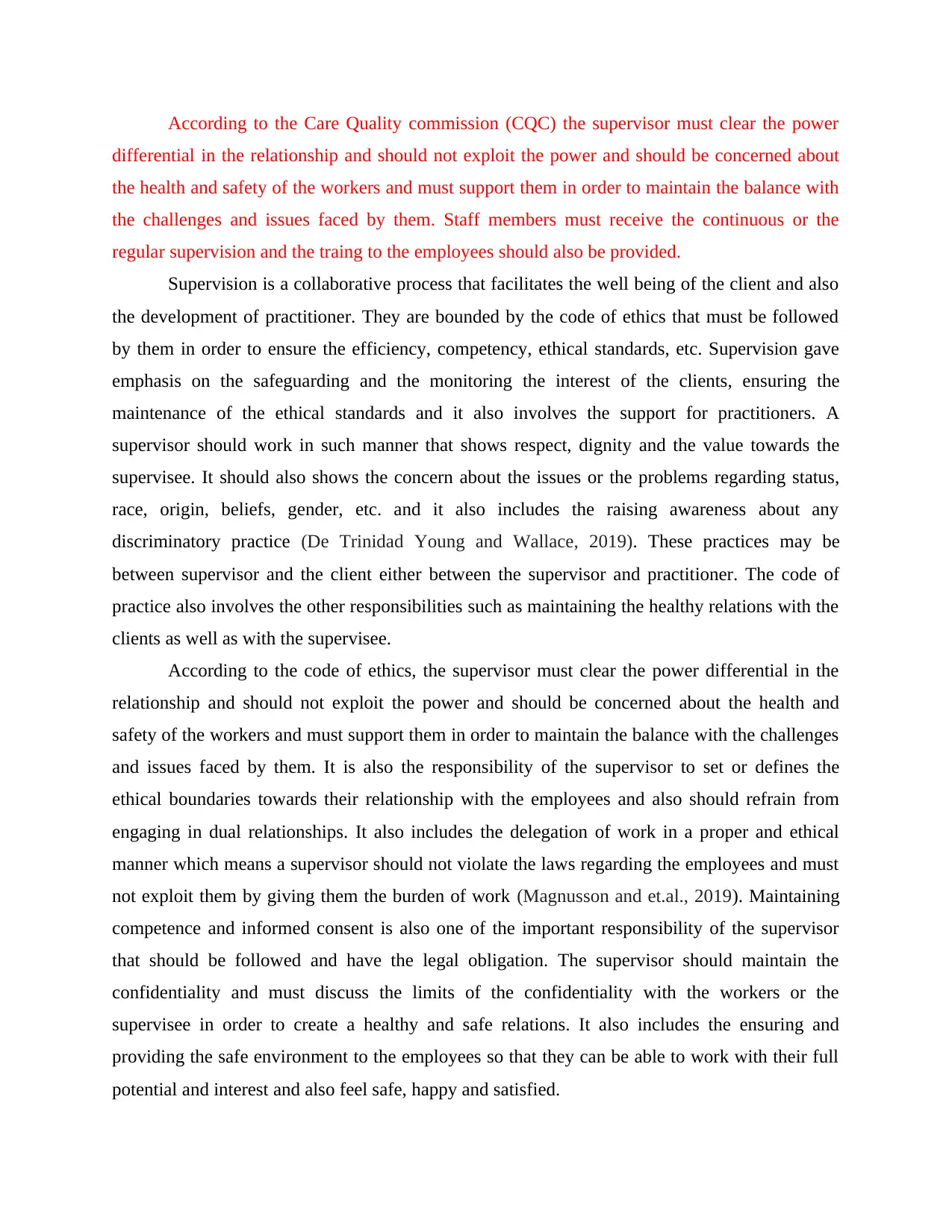
According to the Care Quality commission (CQC) the supervisor must clear the power
differential in the relationship and should not exploit the power and should be concerned about
the health and safety of the workers and must support them in order to maintain the balance with
the challenges and issues faced by them. Staff members must receive the continuous or the
regular supervision and the traing to the employees should also be provided.
Supervision is a collaborative process that facilitates the well being of the client and also
the development of practitioner. They are bounded by the code of ethics that must be followed
by them in order to ensure the efficiency, competency, ethical standards, etc. Supervision gave
emphasis on the safeguarding and the monitoring the interest of the clients, ensuring the
maintenance of the ethical standards and it also involves the support for practitioners. A
supervisor should work in such manner that shows respect, dignity and the value towards the
supervisee. It should also shows the concern about the issues or the problems regarding status,
race, origin, beliefs, gender, etc. and it also includes the raising awareness about any
discriminatory practice (De Trinidad Young and Wallace, 2019). These practices may be
between supervisor and the client either between the supervisor and practitioner. The code of
practice also involves the other responsibilities such as maintaining the healthy relations with the
clients as well as with the supervisee.
According to the code of ethics, the supervisor must clear the power differential in the
relationship and should not exploit the power and should be concerned about the health and
safety of the workers and must support them in order to maintain the balance with the challenges
and issues faced by them. It is also the responsibility of the supervisor to set or defines the
ethical boundaries towards their relationship with the employees and also should refrain from
engaging in dual relationships. It also includes the delegation of work in a proper and ethical
manner which means a supervisor should not violate the laws regarding the employees and must
not exploit them by giving them the burden of work (Magnusson and et.al., 2019). Maintaining
competence and informed consent is also one of the important responsibility of the supervisor
that should be followed and have the legal obligation. The supervisor should maintain the
confidentiality and must discuss the limits of the confidentiality with the workers or the
supervisee in order to create a healthy and safe relations. It also includes the ensuring and
providing the safe environment to the employees so that they can be able to work with their full
potential and interest and also feel safe, happy and satisfied.
differential in the relationship and should not exploit the power and should be concerned about
the health and safety of the workers and must support them in order to maintain the balance with
the challenges and issues faced by them. Staff members must receive the continuous or the
regular supervision and the traing to the employees should also be provided.
Supervision is a collaborative process that facilitates the well being of the client and also
the development of practitioner. They are bounded by the code of ethics that must be followed
by them in order to ensure the efficiency, competency, ethical standards, etc. Supervision gave
emphasis on the safeguarding and the monitoring the interest of the clients, ensuring the
maintenance of the ethical standards and it also involves the support for practitioners. A
supervisor should work in such manner that shows respect, dignity and the value towards the
supervisee. It should also shows the concern about the issues or the problems regarding status,
race, origin, beliefs, gender, etc. and it also includes the raising awareness about any
discriminatory practice (De Trinidad Young and Wallace, 2019). These practices may be
between supervisor and the client either between the supervisor and practitioner. The code of
practice also involves the other responsibilities such as maintaining the healthy relations with the
clients as well as with the supervisee.
According to the code of ethics, the supervisor must clear the power differential in the
relationship and should not exploit the power and should be concerned about the health and
safety of the workers and must support them in order to maintain the balance with the challenges
and issues faced by them. It is also the responsibility of the supervisor to set or defines the
ethical boundaries towards their relationship with the employees and also should refrain from
engaging in dual relationships. It also includes the delegation of work in a proper and ethical
manner which means a supervisor should not violate the laws regarding the employees and must
not exploit them by giving them the burden of work (Magnusson and et.al., 2019). Maintaining
competence and informed consent is also one of the important responsibility of the supervisor
that should be followed and have the legal obligation. The supervisor should maintain the
confidentiality and must discuss the limits of the confidentiality with the workers or the
supervisee in order to create a healthy and safe relations. It also includes the ensuring and
providing the safe environment to the employees so that they can be able to work with their full
potential and interest and also feel safe, happy and satisfied.
Paraphrase This Document
Need a fresh take? Get an instant paraphrase of this document with our AI Paraphraser
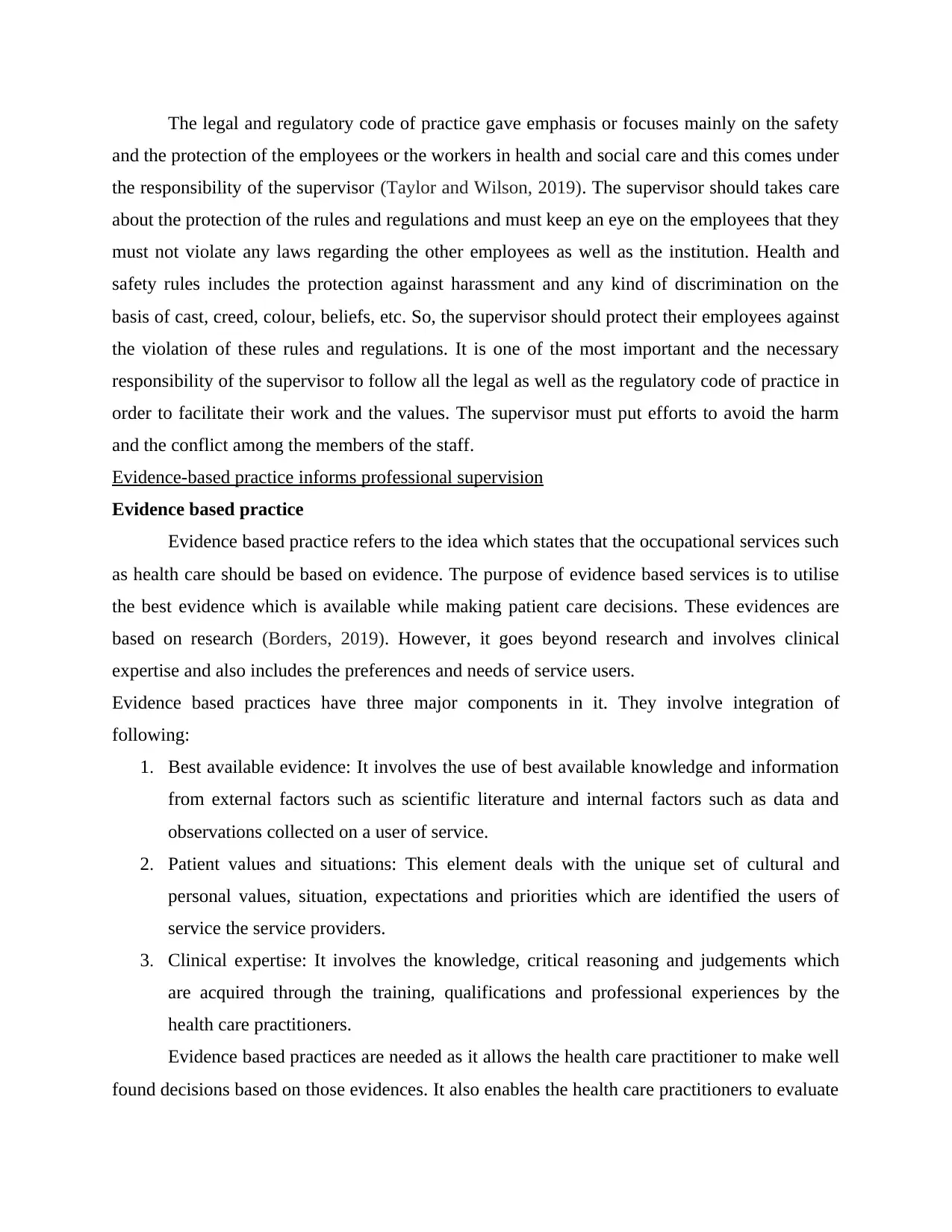
The legal and regulatory code of practice gave emphasis or focuses mainly on the safety
and the protection of the employees or the workers in health and social care and this comes under
the responsibility of the supervisor (Taylor and Wilson, 2019). The supervisor should takes care
about the protection of the rules and regulations and must keep an eye on the employees that they
must not violate any laws regarding the other employees as well as the institution. Health and
safety rules includes the protection against harassment and any kind of discrimination on the
basis of cast, creed, colour, beliefs, etc. So, the supervisor should protect their employees against
the violation of these rules and regulations. It is one of the most important and the necessary
responsibility of the supervisor to follow all the legal as well as the regulatory code of practice in
order to facilitate their work and the values. The supervisor must put efforts to avoid the harm
and the conflict among the members of the staff.
Evidence-based practice informs professional supervision
Evidence based practice
Evidence based practice refers to the idea which states that the occupational services such
as health care should be based on evidence. The purpose of evidence based services is to utilise
the best evidence which is available while making patient care decisions. These evidences are
based on research (Borders, 2019). However, it goes beyond research and involves clinical
expertise and also includes the preferences and needs of service users.
Evidence based practices have three major components in it. They involve integration of
following:
1. Best available evidence: It involves the use of best available knowledge and information
from external factors such as scientific literature and internal factors such as data and
observations collected on a user of service.
2. Patient values and situations: This element deals with the unique set of cultural and
personal values, situation, expectations and priorities which are identified the users of
service the service providers.
3. Clinical expertise: It involves the knowledge, critical reasoning and judgements which
are acquired through the training, qualifications and professional experiences by the
health care practitioners.
Evidence based practices are needed as it allows the health care practitioner to make well
found decisions based on those evidences. It also enables the health care practitioners to evaluate
and the protection of the employees or the workers in health and social care and this comes under
the responsibility of the supervisor (Taylor and Wilson, 2019). The supervisor should takes care
about the protection of the rules and regulations and must keep an eye on the employees that they
must not violate any laws regarding the other employees as well as the institution. Health and
safety rules includes the protection against harassment and any kind of discrimination on the
basis of cast, creed, colour, beliefs, etc. So, the supervisor should protect their employees against
the violation of these rules and regulations. It is one of the most important and the necessary
responsibility of the supervisor to follow all the legal as well as the regulatory code of practice in
order to facilitate their work and the values. The supervisor must put efforts to avoid the harm
and the conflict among the members of the staff.
Evidence-based practice informs professional supervision
Evidence based practice
Evidence based practice refers to the idea which states that the occupational services such
as health care should be based on evidence. The purpose of evidence based services is to utilise
the best evidence which is available while making patient care decisions. These evidences are
based on research (Borders, 2019). However, it goes beyond research and involves clinical
expertise and also includes the preferences and needs of service users.
Evidence based practices have three major components in it. They involve integration of
following:
1. Best available evidence: It involves the use of best available knowledge and information
from external factors such as scientific literature and internal factors such as data and
observations collected on a user of service.
2. Patient values and situations: This element deals with the unique set of cultural and
personal values, situation, expectations and priorities which are identified the users of
service the service providers.
3. Clinical expertise: It involves the knowledge, critical reasoning and judgements which
are acquired through the training, qualifications and professional experiences by the
health care practitioners.
Evidence based practices are needed as it allows the health care practitioner to make well
found decisions based on those evidences. It also enables the health care practitioners to evaluate
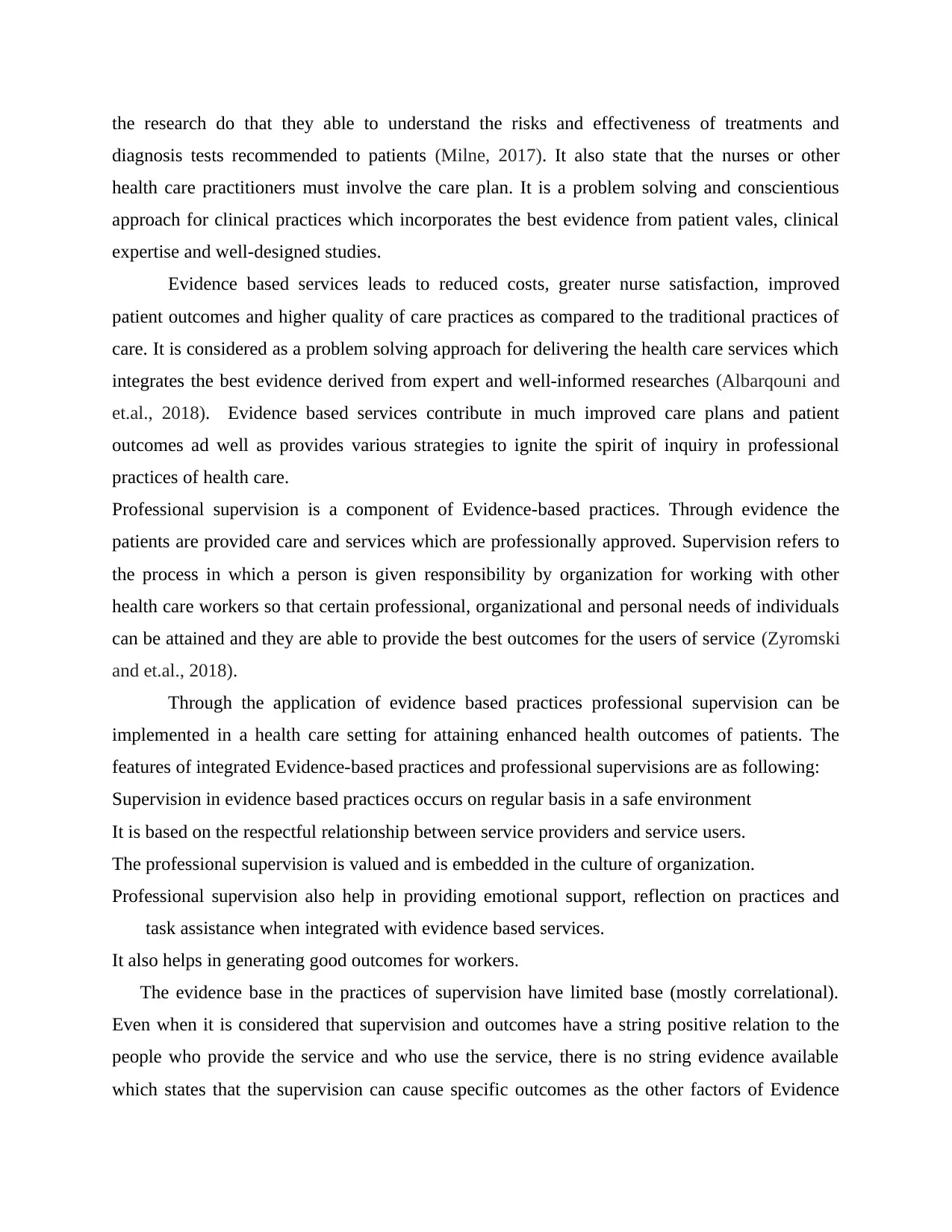
the research do that they able to understand the risks and effectiveness of treatments and
diagnosis tests recommended to patients (Milne, 2017). It also state that the nurses or other
health care practitioners must involve the care plan. It is a problem solving and conscientious
approach for clinical practices which incorporates the best evidence from patient vales, clinical
expertise and well-designed studies.
Evidence based services leads to reduced costs, greater nurse satisfaction, improved
patient outcomes and higher quality of care practices as compared to the traditional practices of
care. It is considered as a problem solving approach for delivering the health care services which
integrates the best evidence derived from expert and well-informed researches (Albarqouni and
et.al., 2018). Evidence based services contribute in much improved care plans and patient
outcomes ad well as provides various strategies to ignite the spirit of inquiry in professional
practices of health care.
Professional supervision is a component of Evidence-based practices. Through evidence the
patients are provided care and services which are professionally approved. Supervision refers to
the process in which a person is given responsibility by organization for working with other
health care workers so that certain professional, organizational and personal needs of individuals
can be attained and they are able to provide the best outcomes for the users of service (Zyromski
and et.al., 2018).
Through the application of evidence based practices professional supervision can be
implemented in a health care setting for attaining enhanced health outcomes of patients. The
features of integrated Evidence-based practices and professional supervisions are as following:
Supervision in evidence based practices occurs on regular basis in a safe environment
It is based on the respectful relationship between service providers and service users.
The professional supervision is valued and is embedded in the culture of organization.
Professional supervision also help in providing emotional support, reflection on practices and
task assistance when integrated with evidence based services.
It also helps in generating good outcomes for workers.
The evidence base in the practices of supervision have limited base (mostly correlational).
Even when it is considered that supervision and outcomes have a string positive relation to the
people who provide the service and who use the service, there is no string evidence available
which states that the supervision can cause specific outcomes as the other factors of Evidence
diagnosis tests recommended to patients (Milne, 2017). It also state that the nurses or other
health care practitioners must involve the care plan. It is a problem solving and conscientious
approach for clinical practices which incorporates the best evidence from patient vales, clinical
expertise and well-designed studies.
Evidence based services leads to reduced costs, greater nurse satisfaction, improved
patient outcomes and higher quality of care practices as compared to the traditional practices of
care. It is considered as a problem solving approach for delivering the health care services which
integrates the best evidence derived from expert and well-informed researches (Albarqouni and
et.al., 2018). Evidence based services contribute in much improved care plans and patient
outcomes ad well as provides various strategies to ignite the spirit of inquiry in professional
practices of health care.
Professional supervision is a component of Evidence-based practices. Through evidence the
patients are provided care and services which are professionally approved. Supervision refers to
the process in which a person is given responsibility by organization for working with other
health care workers so that certain professional, organizational and personal needs of individuals
can be attained and they are able to provide the best outcomes for the users of service (Zyromski
and et.al., 2018).
Through the application of evidence based practices professional supervision can be
implemented in a health care setting for attaining enhanced health outcomes of patients. The
features of integrated Evidence-based practices and professional supervisions are as following:
Supervision in evidence based practices occurs on regular basis in a safe environment
It is based on the respectful relationship between service providers and service users.
The professional supervision is valued and is embedded in the culture of organization.
Professional supervision also help in providing emotional support, reflection on practices and
task assistance when integrated with evidence based services.
It also helps in generating good outcomes for workers.
The evidence base in the practices of supervision have limited base (mostly correlational).
Even when it is considered that supervision and outcomes have a string positive relation to the
people who provide the service and who use the service, there is no string evidence available
which states that the supervision can cause specific outcomes as the other factors of Evidence
You're viewing a preview
Unlock full access by subscribing today!
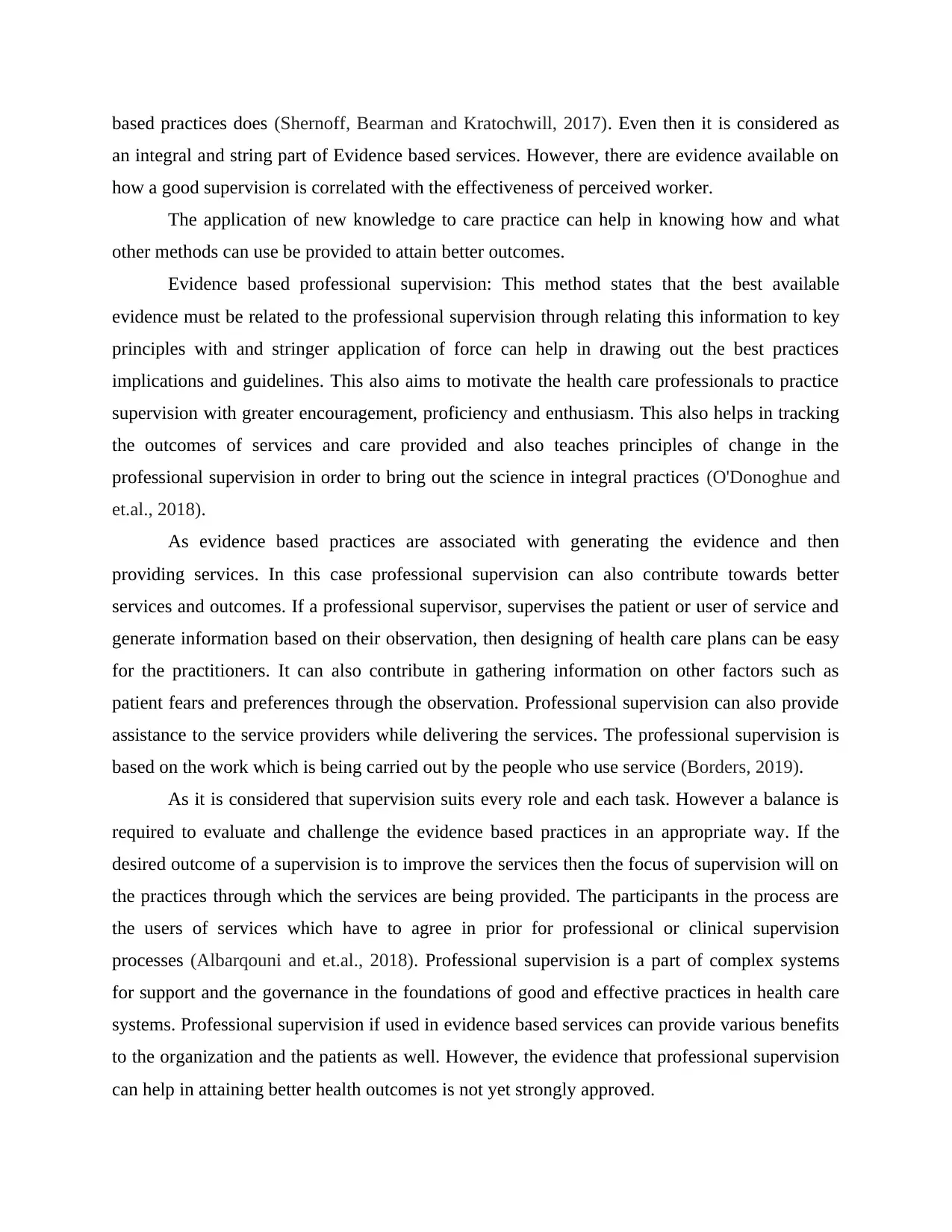
based practices does (Shernoff, Bearman and Kratochwill, 2017). Even then it is considered as
an integral and string part of Evidence based services. However, there are evidence available on
how a good supervision is correlated with the effectiveness of perceived worker.
The application of new knowledge to care practice can help in knowing how and what
other methods can use be provided to attain better outcomes.
Evidence based professional supervision: This method states that the best available
evidence must be related to the professional supervision through relating this information to key
principles with and stringer application of force can help in drawing out the best practices
implications and guidelines. This also aims to motivate the health care professionals to practice
supervision with greater encouragement, proficiency and enthusiasm. This also helps in tracking
the outcomes of services and care provided and also teaches principles of change in the
professional supervision in order to bring out the science in integral practices (O'Donoghue and
et.al., 2018).
As evidence based practices are associated with generating the evidence and then
providing services. In this case professional supervision can also contribute towards better
services and outcomes. If a professional supervisor, supervises the patient or user of service and
generate information based on their observation, then designing of health care plans can be easy
for the practitioners. It can also contribute in gathering information on other factors such as
patient fears and preferences through the observation. Professional supervision can also provide
assistance to the service providers while delivering the services. The professional supervision is
based on the work which is being carried out by the people who use service (Borders, 2019).
As it is considered that supervision suits every role and each task. However a balance is
required to evaluate and challenge the evidence based practices in an appropriate way. If the
desired outcome of a supervision is to improve the services then the focus of supervision will on
the practices through which the services are being provided. The participants in the process are
the users of services which have to agree in prior for professional or clinical supervision
processes (Albarqouni and et.al., 2018). Professional supervision is a part of complex systems
for support and the governance in the foundations of good and effective practices in health care
systems. Professional supervision if used in evidence based services can provide various benefits
to the organization and the patients as well. However, the evidence that professional supervision
can help in attaining better health outcomes is not yet strongly approved.
an integral and string part of Evidence based services. However, there are evidence available on
how a good supervision is correlated with the effectiveness of perceived worker.
The application of new knowledge to care practice can help in knowing how and what
other methods can use be provided to attain better outcomes.
Evidence based professional supervision: This method states that the best available
evidence must be related to the professional supervision through relating this information to key
principles with and stringer application of force can help in drawing out the best practices
implications and guidelines. This also aims to motivate the health care professionals to practice
supervision with greater encouragement, proficiency and enthusiasm. This also helps in tracking
the outcomes of services and care provided and also teaches principles of change in the
professional supervision in order to bring out the science in integral practices (O'Donoghue and
et.al., 2018).
As evidence based practices are associated with generating the evidence and then
providing services. In this case professional supervision can also contribute towards better
services and outcomes. If a professional supervisor, supervises the patient or user of service and
generate information based on their observation, then designing of health care plans can be easy
for the practitioners. It can also contribute in gathering information on other factors such as
patient fears and preferences through the observation. Professional supervision can also provide
assistance to the service providers while delivering the services. The professional supervision is
based on the work which is being carried out by the people who use service (Borders, 2019).
As it is considered that supervision suits every role and each task. However a balance is
required to evaluate and challenge the evidence based practices in an appropriate way. If the
desired outcome of a supervision is to improve the services then the focus of supervision will on
the practices through which the services are being provided. The participants in the process are
the users of services which have to agree in prior for professional or clinical supervision
processes (Albarqouni and et.al., 2018). Professional supervision is a part of complex systems
for support and the governance in the foundations of good and effective practices in health care
systems. Professional supervision if used in evidence based services can provide various benefits
to the organization and the patients as well. However, the evidence that professional supervision
can help in attaining better health outcomes is not yet strongly approved.
Paraphrase This Document
Need a fresh take? Get an instant paraphrase of this document with our AI Paraphraser
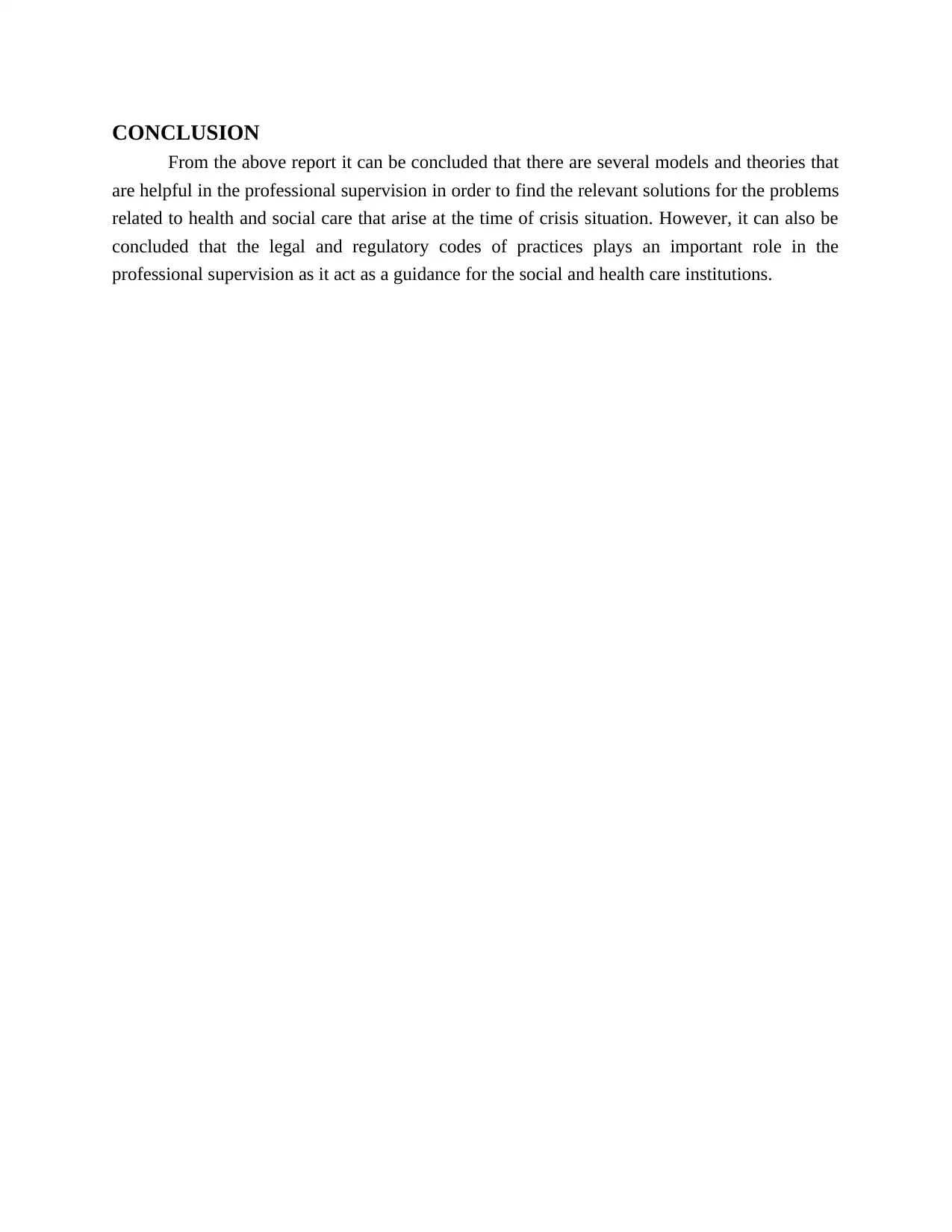
CONCLUSION
From the above report it can be concluded that there are several models and theories that
are helpful in the professional supervision in order to find the relevant solutions for the problems
related to health and social care that arise at the time of crisis situation. However, it can also be
concluded that the legal and regulatory codes of practices plays an important role in the
professional supervision as it act as a guidance for the social and health care institutions.
From the above report it can be concluded that there are several models and theories that
are helpful in the professional supervision in order to find the relevant solutions for the problems
related to health and social care that arise at the time of crisis situation. However, it can also be
concluded that the legal and regulatory codes of practices plays an important role in the
professional supervision as it act as a guidance for the social and health care institutions.
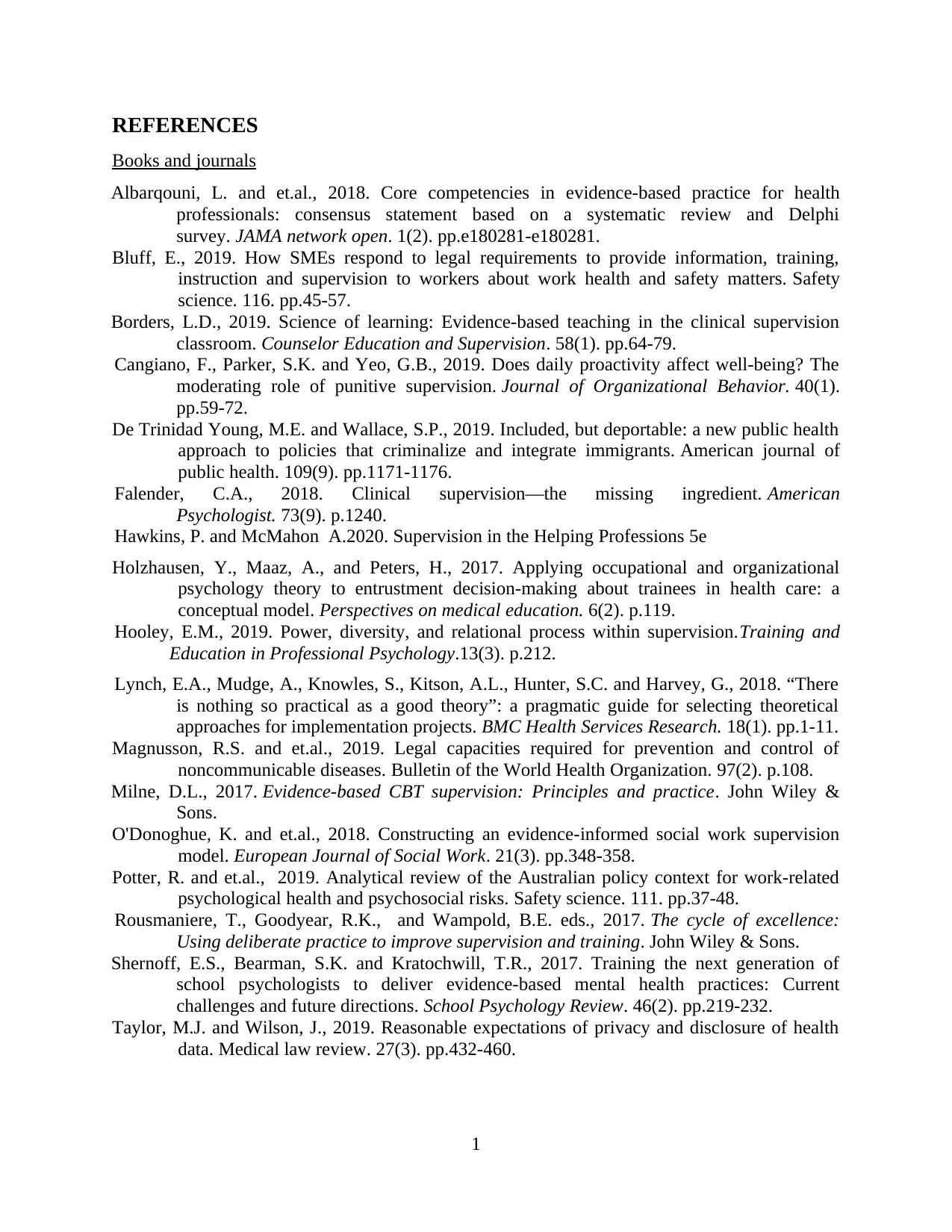
REFERENCES
Books and journals
Albarqouni, L. and et.al., 2018. Core competencies in evidence-based practice for health
professionals: consensus statement based on a systematic review and Delphi
survey. JAMA network open. 1(2). pp.e180281-e180281.
Bluff, E., 2019. How SMEs respond to legal requirements to provide information, training,
instruction and supervision to workers about work health and safety matters. Safety
science. 116. pp.45-57.
Borders, L.D., 2019. Science of learning: Evidence‐based teaching in the clinical supervision
classroom. Counselor Education and Supervision. 58(1). pp.64-79.
Cangiano, F., Parker, S.K. and Yeo, G.B., 2019. Does daily proactivity affect well‐being? The
moderating role of punitive supervision. Journal of Organizational Behavior. 40(1).
pp.59-72.
De Trinidad Young, M.E. and Wallace, S.P., 2019. Included, but deportable: a new public health
approach to policies that criminalize and integrate immigrants. American journal of
public health. 109(9). pp.1171-1176.
Falender, C.A., 2018. Clinical supervision—the missing ingredient. American
Psychologist. 73(9). p.1240.
Hawkins, P. and McMahon A.2020. Supervision in the Helping Professions 5e
Holzhausen, Y., Maaz, A., and Peters, H., 2017. Applying occupational and organizational
psychology theory to entrustment decision-making about trainees in health care: a
conceptual model. Perspectives on medical education. 6(2). p.119.
Hooley, E.M., 2019. Power, diversity, and relational process within supervision.Training and
Education in Professional Psychology.13(3). p.212.
Lynch, E.A., Mudge, A., Knowles, S., Kitson, A.L., Hunter, S.C. and Harvey, G., 2018. “There
is nothing so practical as a good theory”: a pragmatic guide for selecting theoretical
approaches for implementation projects. BMC Health Services Research. 18(1). pp.1-11.
Magnusson, R.S. and et.al., 2019. Legal capacities required for prevention and control of
noncommunicable diseases. Bulletin of the World Health Organization. 97(2). p.108.
Milne, D.L., 2017. Evidence-based CBT supervision: Principles and practice. John Wiley &
Sons.
O'Donoghue, K. and et.al., 2018. Constructing an evidence-informed social work supervision
model. European Journal of Social Work. 21(3). pp.348-358.
Potter, R. and et.al., 2019. Analytical review of the Australian policy context for work-related
psychological health and psychosocial risks. Safety science. 111. pp.37-48.
Rousmaniere, T., Goodyear, R.K., and Wampold, B.E. eds., 2017. The cycle of excellence:
Using deliberate practice to improve supervision and training. John Wiley & Sons.
Shernoff, E.S., Bearman, S.K. and Kratochwill, T.R., 2017. Training the next generation of
school psychologists to deliver evidence-based mental health practices: Current
challenges and future directions. School Psychology Review. 46(2). pp.219-232.
Taylor, M.J. and Wilson, J., 2019. Reasonable expectations of privacy and disclosure of health
data. Medical law review. 27(3). pp.432-460.
1
Books and journals
Albarqouni, L. and et.al., 2018. Core competencies in evidence-based practice for health
professionals: consensus statement based on a systematic review and Delphi
survey. JAMA network open. 1(2). pp.e180281-e180281.
Bluff, E., 2019. How SMEs respond to legal requirements to provide information, training,
instruction and supervision to workers about work health and safety matters. Safety
science. 116. pp.45-57.
Borders, L.D., 2019. Science of learning: Evidence‐based teaching in the clinical supervision
classroom. Counselor Education and Supervision. 58(1). pp.64-79.
Cangiano, F., Parker, S.K. and Yeo, G.B., 2019. Does daily proactivity affect well‐being? The
moderating role of punitive supervision. Journal of Organizational Behavior. 40(1).
pp.59-72.
De Trinidad Young, M.E. and Wallace, S.P., 2019. Included, but deportable: a new public health
approach to policies that criminalize and integrate immigrants. American journal of
public health. 109(9). pp.1171-1176.
Falender, C.A., 2018. Clinical supervision—the missing ingredient. American
Psychologist. 73(9). p.1240.
Hawkins, P. and McMahon A.2020. Supervision in the Helping Professions 5e
Holzhausen, Y., Maaz, A., and Peters, H., 2017. Applying occupational and organizational
psychology theory to entrustment decision-making about trainees in health care: a
conceptual model. Perspectives on medical education. 6(2). p.119.
Hooley, E.M., 2019. Power, diversity, and relational process within supervision.Training and
Education in Professional Psychology.13(3). p.212.
Lynch, E.A., Mudge, A., Knowles, S., Kitson, A.L., Hunter, S.C. and Harvey, G., 2018. “There
is nothing so practical as a good theory”: a pragmatic guide for selecting theoretical
approaches for implementation projects. BMC Health Services Research. 18(1). pp.1-11.
Magnusson, R.S. and et.al., 2019. Legal capacities required for prevention and control of
noncommunicable diseases. Bulletin of the World Health Organization. 97(2). p.108.
Milne, D.L., 2017. Evidence-based CBT supervision: Principles and practice. John Wiley &
Sons.
O'Donoghue, K. and et.al., 2018. Constructing an evidence-informed social work supervision
model. European Journal of Social Work. 21(3). pp.348-358.
Potter, R. and et.al., 2019. Analytical review of the Australian policy context for work-related
psychological health and psychosocial risks. Safety science. 111. pp.37-48.
Rousmaniere, T., Goodyear, R.K., and Wampold, B.E. eds., 2017. The cycle of excellence:
Using deliberate practice to improve supervision and training. John Wiley & Sons.
Shernoff, E.S., Bearman, S.K. and Kratochwill, T.R., 2017. Training the next generation of
school psychologists to deliver evidence-based mental health practices: Current
challenges and future directions. School Psychology Review. 46(2). pp.219-232.
Taylor, M.J. and Wilson, J., 2019. Reasonable expectations of privacy and disclosure of health
data. Medical law review. 27(3). pp.432-460.
1
You're viewing a preview
Unlock full access by subscribing today!
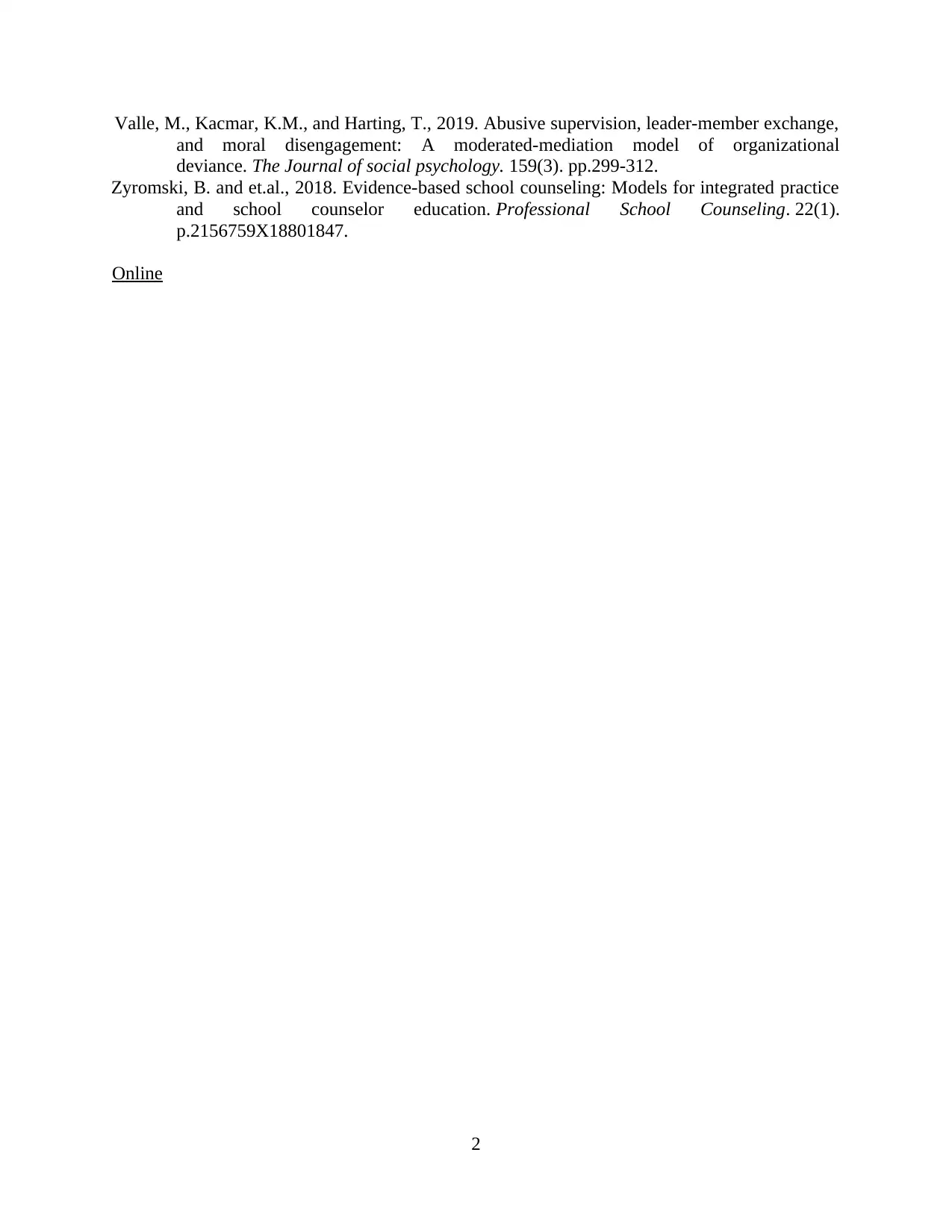
Valle, M., Kacmar, K.M., and Harting, T., 2019. Abusive supervision, leader-member exchange,
and moral disengagement: A moderated-mediation model of organizational
deviance. The Journal of social psychology. 159(3). pp.299-312.
Zyromski, B. and et.al., 2018. Evidence-based school counseling: Models for integrated practice
and school counselor education. Professional School Counseling. 22(1).
p.2156759X18801847.
Online
2
and moral disengagement: A moderated-mediation model of organizational
deviance. The Journal of social psychology. 159(3). pp.299-312.
Zyromski, B. and et.al., 2018. Evidence-based school counseling: Models for integrated practice
and school counselor education. Professional School Counseling. 22(1).
p.2156759X18801847.
Online
2
1 out of 13
Related Documents
Your All-in-One AI-Powered Toolkit for Academic Success.
+13062052269
info@desklib.com
Available 24*7 on WhatsApp / Email
![[object Object]](/_next/static/media/star-bottom.7253800d.svg)
Unlock your academic potential
© 2024 | Zucol Services PVT LTD | All rights reserved.





